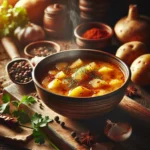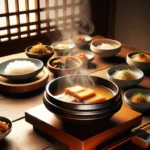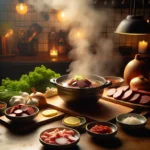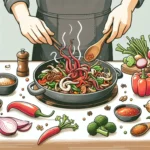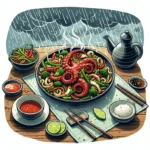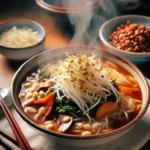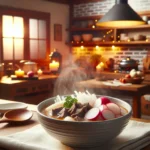Imagine a warm bowl of Korean Pork Bone Hangover Soup, bursting with rich flavors that cradle your senses and revive your spirit. This beloved dish, known as Ppyeo Haejangguk, is not just a remedy for the weary; it’s a culinary experience that warms both body and soul. Have you ever wondered how such a simple combination of ingredients can create such a heartwarming elixir? Dive into our journey of crafting this ancient delicacy, where each step reveals a story and every flavor dances on your palate. Whether you’re battling a hangover or simply craving comfort, this recipe will inspire you to savor the beauty of Korean cuisine. Let’s embark on this delicious adventure together!
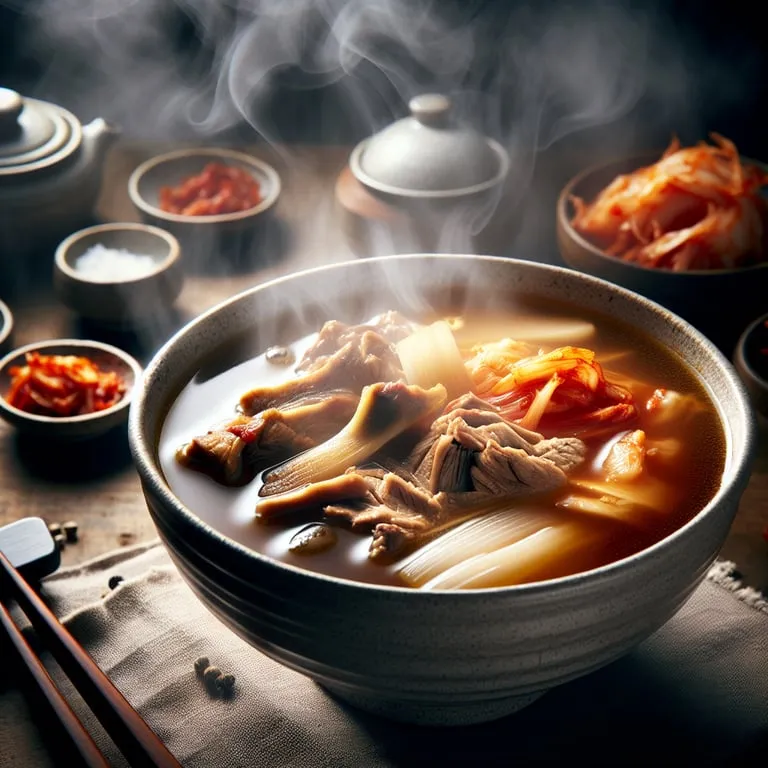
Ingredients You’ll Need
To create a sumptuous bowl of Korean Pork Bone Hangover Soup (Ppyeo Haejangguk), gathering the right ingredients is crucial! Let’s dive into the essentials you’ll need, shall we? 🥢
Essential Ingredients
- Pork bones (2-3 pounds): Achieving a rich and hearty broth starts with quality pork bones. Look for a mix of spine and neck bones, as these will impart the gelatinous texture and robust flavor you’re after. The magic of simmering these bones for hours is what makes this dish so beloved. 🥩
- Water (12 cups): The base of your broth, water plays a vital role. Consider using filtered water for a cleaner taste and to keep the flavors from other ingredients bright and clear.
- Garlic (10 cloves, crushed): There’s no such thing as too much garlic! It not only boosts the flavor but also lends an aromatic essence to your stock. Feel free to adjust to your palate, but remember: this is a dish that celebrates robust flavors! 🧄✨
- Ginger (1 piece, about 2 inches, sliced): A common secret among cooks, ginger balances the richness of the pork well. Slice it thinly to release its flavor fully.
- Green onions (4-6 stalks): These versatile bulbs add a fresh, vibrant note! Use them both in the broth and as a garnish to enhance your soup’s aroma and flavor profile. 🌿
- Soy sauce (1/4 cup): This essential condiment will provide a depth of flavor and color. Choose a high-quality variety for the best results!
- Salt (to taste): Not all salts are created equal! Sea salt or kosher salt is ideal for this recipe, allowing you to control the salinity without overwhelming the other tastes.
- Red chili pepper flakes (gochugaru, 1-2 tablespoons): Depending on your heat tolerance, this spicy addition gives the dish its signature warmth. Just be cautious not to go overboard unless you crave a fiery experience! 🌶️🔥
- Rice (to serve): Often served alongside or within your soup, freshly cooked rice enhances the overall experience and rounds out the meal.
- Optional Ingredients:
- Radish (1, diced): Adds a delightful crunch and subtle sweetness.
- Eggs (for boiling and garnishing): Soft-boiled eggs take it to another level! 🍳
- Sesame oil (1 teaspoon): A drizzle of this oil at the end adds depth and richness.
Each of these ingredients brings its character to the bowl, transforming humble elements into a soulful meal that warms the heart and rejuvenates the spirit. As you gather your ingredients, feel free to explore local markets or specialty stores to discover fresh, high-quality options! The wholesome flavors of Ppyeo Haejangguk await, and it’s all about starting with the best foundation. Enjoy the journey of cooking! 🍜✨
Step-by-Step Cooking Instructions
To unleash the rich flavors of Korean Pork Bone Hangover Soup, following precise steps is essential. Let’s dive into the heart of the cooking process and transform simple ingredients into a delightful, soul-soothing dish! 😊
Preparation of Ingredients
Start with 2.5 pounds of pork bones, preferably neck bones or leg bones, as they provide the best flavor. Additionally, gather 1 large onion, 6 cloves of garlic, a thumb-sized piece of ginger, and 1 scallion. ⠀
Soaking the Bones
Place the pork bones in a large pot and cover them with cold water. Let them soak for 2 hours. This step helps draw out impurities and results in a clearer soup! Afterward, discard the water and rinse the bones under cold running water for complete purification.
Blanching
In a clean pot, add the soaked bones, cover with fresh water, and bring to a rolling boil. Once boiling, add the onion, garlic, and ginger to the pot. Allow this to simmer for about 10 minutes. This step not only enhances flavor but also further cleanses the meat! 🎉
Simmering for Depth
After blanching, drain the pot and rinse the bones again. Then, place the bones back into the pot and cover with around 12 cups of water. Bring this to a boil, then reduce the heat to low and let it simmer for at least 3 to 4 hours. Yes, patience is key here! During this simmering process, the collagen from the bones infuses the broth, creating a deliciously rich flavor.
Spicing It Up
For those who enjoy a kick, stir in 2 tablespoons of Korean chili flakes (Gochugaru) and 2 tablespoons of soy sauce after the initial hour of simmering. This adds layers of flavor that dance around the palate! If you’re looking for extra garlicky goodness, feel free to add minced garlic (around 2-3 cloves).
Final Touches
After hours of simmering, remove the bones. Use a fine-mesh strainer to separate the broth from solid matter, ensuring a smooth texture. At this stage, season the soup further with salt and pepper to your liking. A sprinkle of sesame oil right before serving can enhance the aroma! 🌿
Adding Vegetables
In the last 30 minutes of cooking, toss in chopped radish (mu) and an optional couple of potatoes. This will add texture and sweetness to the broth.
Garnishing
Just before serving, finely chop the scallion and sprinkle over the soup for a fresh, vibrant touch. Additionally, if you wish, a sprinkle of toasted sesame seeds can add a final layer of sophistication!
Serve it Up
Ladle generous amounts of soup into bowls and accompany the warmth with a side of steamed rice or kimchi for an authentic experience! The beauty of Ppyeo Haejangguk lies in its ability to revive the spirit and warm the soul—perfect for those mornings after a night out!
Following these structured steps will not only guarantee that the soup tastes authentic but also has that velvety texture that everyone loves. Enjoy the journey of cooking, and let the savory aroma fill your kitchen! 🍲✨
Tips for Achieving the Perfect Flavor
Achieving the perfect flavor in Korean Pork Bone Hangover Soup, or Ppyeo Haejangguk, transcends mere ingredients; it’s an art form that balances depth, richness, and harmony. To create a broth that sings with flavor, consider some specific techniques and insights:
1. Choosing Your Pork Bones Wisely
Start with a combination of back bones and trotters. Back bones provide a clean flavor, while trotters add richness due to the gelatin content. Ideally, aim for a ratio of 70% back bones to 30% trotters for a perfect mouthfeel and depth.
2. Properly Roasting the Bones
Before boiling, roasting the bones at 400°F (200°C) for about 30-45 minutes enhances their flavors. This process develops a robust, deeply caramelized taste that sets the foundation of your broth. The transformation of color to a delightful golden brown is an indication of perfect roasting! ✨
3. The Soaking Technique
After roasting, soak the bones in cold water for 30 minutes to remove impurities. This step is critical, as it ensures clarity and purity in your final soup; nobody wants a cloudy broth.
4. The Magical Aromatics
Alongside your bones, incorporate aromatics like garlic (at least 10 cloves for a robust base!), ginger (2-3 slices), and scallions. These ingredients infuse the broth with layers of flavor. Adding a sprinkle of whole black peppercorns (around 10-15) during the simmering process enhances the warmth and complexity!
5. Simmer Time
For the broth to truly develop its essence, a long simmer is essential. Aim for at least 6-8 hours of simmering, or even longer if you’re adventurous! The longer it bubbles, the more flavor leaches from the bones and aromatics. And don’t forget to skim any scum that rises to the surface—this keeps your broth looking pristine and clean!
6. Seasoning to Perfection
Once the broth is nearly done, season with salt judiciously. Start with about a tablespoon and adjust according to taste. For an enhanced umami experience, a splash of soy sauce and a hint of sesame oil can bring your soup to life! 🌱
7. Finish with Freshness
Adding fresh ingredients right before serving can brighten up the dish. Consider a handful of chopped watercress or a sprinkle of sesame seeds for that nutty finish! You can’t forget the classic topping of sliced green onions for that additional crunch and freshness!
8. Balance is Key
The addition of gochugaru (Korean red pepper flakes) is essential for that signature kick, but moderation is crucial. Start with a teaspoon and adjust according to your desired spice level. Mix in some fermented cabbage or kimchi for an extra tang that pairs beautifully!
9. Let It Rest
After cooking, let the soup sit in the refrigerator overnight! This allows flavors to meld and intensify—if you can resist the temptation to dig in sooner. Reheat gently before serving, and taste before you serve. You may want to adjust seasonings one last time!
10. A Final Personal Touch
Every family has its twist! Don’t hesitate to experiment with different toppings, such as sliced boiled eggs or even a touch of lime juice for brightness. Your own signature ingredient can truly elevate the dish to new heights. 🍳✨
Embracing these tips will not only enhance the flavor but also help you create a comforting bowl of Ppyeo Haejangguk that resonates with warmth and complexity, providing the ultimate hangover cure or a satisfying meal any day of the week!
Serving Suggestions and Pairing Ideas
Korean Pork Bone Hangover Soup, known as Ppyeo Haejangguk, is more than just a nourishing dish; it’s a culinary experience that delights the senses. The rich, flavorful broth paired with tender pork bones transports one to a comforting haven. So, how can one elevate this remarkable dish to new heights? Let’s explore some mouthwatering serving suggestions and pairing ideas that will surely impress! 🍜✨
Garnishing and Serving Suggestions
To fully appreciate the bold flavors of Haejangguk, consider garnishing it with thinly sliced green onions and a sprinkle of sesame seeds. These additions not only enhance the visual appeal but also contribute to a fresh burst of flavor that complements the soup’s heartiness. Did you know that a pinch of gochugaru (Korean red pepper flakes) can give a spicy kick? It’s true! Spicy lovers often indulge in adding this fiery element to their servings for an extra zing.🔥
Accompaniments
For those seeking a delightful accompaniment, serve the soup alongside an assortment of banchan (Korean side dishes). Kimchi, whether it’s the traditional napa cabbage or spicy radish variety, provides an excellent counterbalance to the richness of the soup. If you want to add an element of crunch, pickled cucumbers also work wonders! The tangy, refreshing notes will cleanse the palate beautifully between those hearty spoonfuls. 🥒🥢
Pairing with Rice
Pairing the Ppyeo Haejangguk with rice is another fantastic suggestion! A bowl of steamed white rice, perhaps sprinkled with a tiny bit of sea salt, absorbs the savory broth perfectly. It’s an age-old combination, bringing out the best in both the soup and the rice. And of course, don’t forget your chopsticks! Using them to enjoy bites of meat and rice creates a rhythmic experience that is quintessentially Korean. 🍚❤️
Beverage Pairings
If you’re aiming for beverages to round out your dining experience, why not consider traditional Korean drinks? Makgeolli, a milky rice wine, is a classic pairing that complements the deep flavors of the soup. Its mild sweetness and slightly tangy notes can balance the rich broth and tender meat perfectly. Alternatively, an icy cold beer also makes a fantastic accompaniment, especially on a warm day! 🍺🥳
Creative Pairings
For a more modern twist, craft cocktails featuring Korean ingredients can elevate your dining occasion. Imagine a soju-based cocktail infused with lemongrass for a delightful citrus twist! The options are endless and allow you to get creative! 🍹🌟
Experimenting with Flavors
Lastly, don’t shy away from experimenting! Your palate is your guide. Some adventurous souls enjoy their Haejangguk with a side of spicy tteokbokki (Korean spicy rice cakes) for an extravagant feast of flavors and textures! 🍲❤️
In a world where dining experiences should be cherished, serving suggestions and pairing ideas can transform your Haejangguk from a hearty meal into a feast worthy of celebration! Embrace your culinary journey and relish in the joy of pairing delicious flavors together! 🎉🍽️
In conclusion, Korean Pork Bone Hangover Soup is not merely a dish; it’s a comforting embrace that warms the soul. Each spoonful tells a story of tradition and care, inviting you to explore the depth of flavors and indulge in its heartiness. To elevate your experience, consider pairing it with your favorite side dishes or a refreshing beverage. As you embark on this culinary journey, remember that the joy of cooking lies in experimentation and sharing moments with loved ones. Embrace the flavors, and let this exquisite soup become a cherished part of your meals. Your kitchen awaits the magic of Ppyeo Haejangguk!
